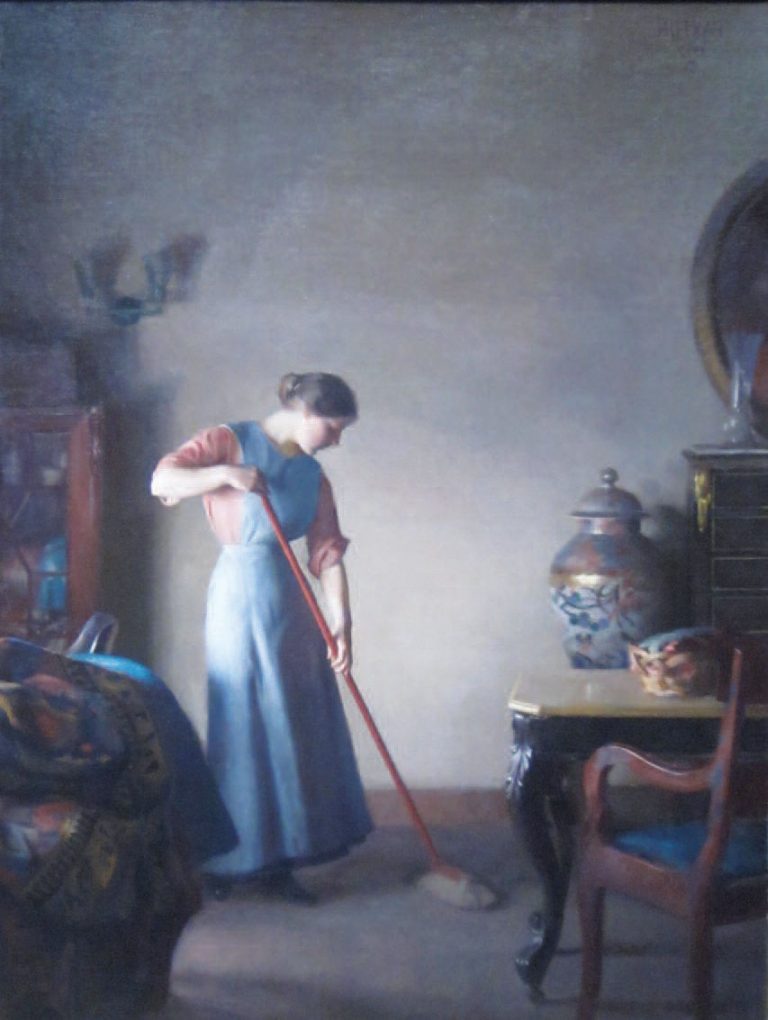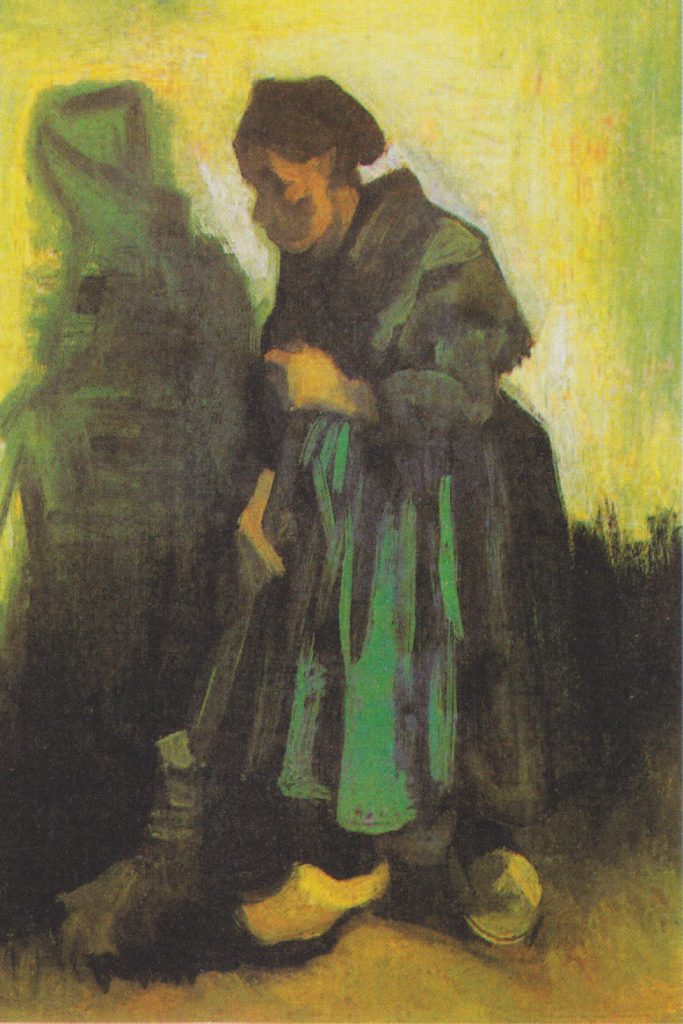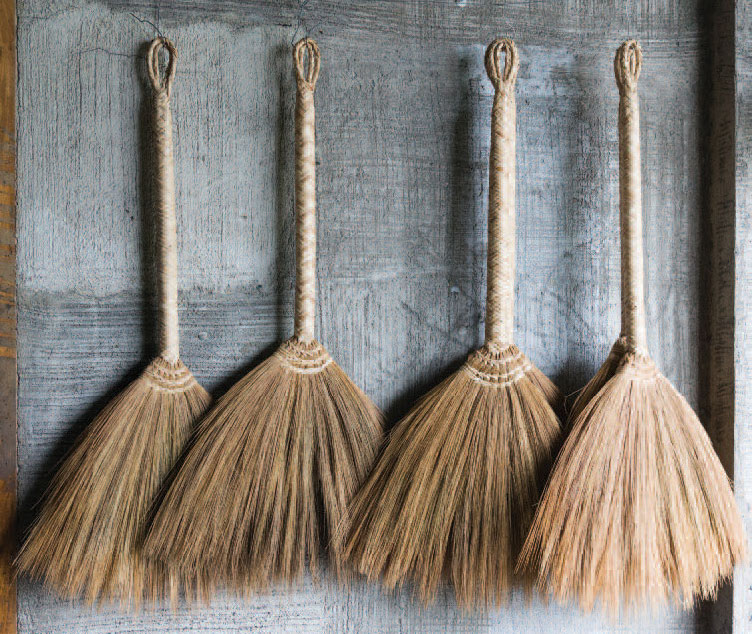The Art of Cleaning
The Art of Cleaning, by Llewellyn Vaughan-Lee and Hilary Hart
April 29, 2017
Girl Sweeping. William McGregor Paxton, 1912. Pennsylvania Academy of the Fine Arts
In the busyness of our contemporary life we are drawn into ceaseless activity that often separates us from the deeper dimension of our self. With our smart phones and computer screens we often remain caught on the surface of our lives, amidst the noise and chatter that continually distract us, that stop us from being rooted in our true nature. Unaware, we are drowned deeper and deeper in a culture of soulless materialism.
At this time I find it more and more important to have outer activities that can connect us to what is more natural and help us live in relationship to the deep root of our being, and in an awareness of the moment which alone can give real meaning to our everyday existence. Over the years I have developed a number of simple practices that bring together action and a quality of mindfulness, or deepening awareness, that can nourish our lives in hidden ways. These activities, like mindful walking, cooking with love and attention, can reconnect us with the web of life, our natural interconnection with life in its beauty and wonder. They can help us “declutter” our outer life and instead become rooted in what is simple and real. One of these practices, which combines action with mindfulness, is cleaning.
The Art of Cleaning
Bamboo shadows sweep the stairs,
But no dust is stirred.
Moonlight penetrates the depths of the pool,
But no trace is left in the water.–Nyogen Senzaki
The art of cleaning is a simple spiritual activity that is often overlooked. The image of the monk sweeping the courtyard has a deep significance, because without the practice of cleaning there can be no empty space, no space for a deep communion with the sacred. Outer and inner cleaning belong to the foundation of spiritual practice, and as the monk’s broom touches the ground, it has a particular relationship to the Earth. We need to create a sacred space in order to live in relationship to the sacred within ourselves and within creation.
In today’s busy life cleaning one’s home is often considered a chore. We may spend time and energy (and expensive products) in our daily ritual bathing, but the simple art of cleaning our living space is rarely given precedence. Our culture calls to us to use products that will kill all of the “germs” that surround us, products that are often more toxic than the germs, but do we give attention, mindfulness, to caring for the space in which we live? Are we fully present with our brush or vacuum cleaner?
Once I realized that everything is part of one living whole, that nothing is separate, I understood how everything needs care and attention. I bring this feeling and awareness into my cleaning. Cleaning a table, dusting a shelf, I give attention and love, because everything responds to love and care—not just people, or animals, or plants, but everything. I feel strongly that just as I should have only what I need, I should have only what I can look after, love, and care for. It is a simple recognition of the sacred that is present within everything, and a way to live from the heart in everyday life. Maybe, having been brought up in a family without love or care, I feel this need especially strongly, but I sense that it comes from a deeper knowing of how everything is part of the fabric of love—that creation is woven out of love. And so when I clean I am also looking after, caring for, what is around me, knowing that it too needs to be loved.
Peasant Woman Sweeping the Floor. Vincent van Gogh, 1885. Oil on canvas on wood.
Kröller-Müller Museum, Otterlo, Netherlands
I must admit that I love to clean. I find cleaning deeply reassuring. Personally I love emptiness, inner and outer space. In cleaning my living space I am creating emptiness, clearing up the debris that so easily accumulates. And when one cleans with love and attention one is not just vacuuming the dust, but also the psychic debris, even the worthless thought-forms that stay in the air. Because our culture values only what it can see and touch, we do not understand this invisible accumulation. But it is real, and without conscious attention it clutters our life more than we realize. Just as ritual bathing prepares the worshipper, or just as we may take off our shoes at the entrance to a temple or mosque (or even a friend’s home), cleaning is an important preparation for living with the sacred in our daily life.
When I first started lecturing, traveling over America, I would stay in people’s houses. At the time I was lecturing mainly to Jungian psychology groups, and so would sometimes stay in the house of a therapist. I remember one night being given a bed in the “spare room,” which was also my host’s therapy room. After a few restless hours I gave up trying to sleep and realized that I was lying in the psychic soup of all of his patients. Through his therapy work he brought unconscious feelings to the surface, brought shadow dynamics, anger, and depression into consciousness. And so they were floating around the room, waiting to attach themselves to the next person who entered. The therapist had no understanding of psychic cleaning. Sadly it had not been part of his training or practice. The air was dense with discarded psychic contents.
This is not uncommon. Often people who do healing wash or shake their hands afterward, but then the illness just goes into the water or into the air, to be drunk or breathed by another. When my teacher was in India with her Sufi sheikh, she would sometimes witness him performing a healing. She noticed that after each healing he would cup his hands and bring something to his mouth. She realized that he was inwardly digesting the sickness that he had cleansed, so that it would not just stay in the air and attach itself to another person.
Ecological awareness teaches us the importance of recycling and composting. The waste from our daily lives should not be allowed just to accumulate in a landfill. Nor should it be allowed to get into our water, which in a less visible way is becoming toxic with all the tranquilizers and other drugs that go through our system into the water, affecting and mutating the fish. There are many ecologically aware people who make it a practice to leave as little as possible in their garbage bins for the landfills, and work to safeguard the food and water supply, and this is very commendable. But if we are to practice spiritual ecology, if we are to include the spiritual in our ecological awareness, we need to bring a greater awareness to all the debris we leave behind. We need to learn how to clear up after ourselves, how to keep an empty space—how to be attentive in our cleaning.
When we bring a quality of attention in our cleaning, the psychic debris can be absorbed along with the dust. Often the attention is linked to the breath, so the two work together.1 When we work this way the debris does not harm us, and I have found a deep satisfaction in this practice.
Our present culture teaches us to accumulate, but not how to make empty. But for real spiritual work in the inner and outer worlds, in order to give space to the divine, in order to return to the sacred, we need to practice a certain purification in our daily lives. We learn to eat consciously, to be attentive to our outer environment, to sweep our courtyard. We also need to learn how to clean our house, both physically and inwardly. Just as we need to learn to empty our mind in meditation, to clear away the clutter of unnecessary thoughts, so do we need to consciously clean our living space. Dusting, sweeping, vacuuming with attention, we bring a certain awareness to the ground of our being. This has to do with respect for our environment.
Handmade brooms, Philippines. Photo by CEphoto, Uwe Aranas
In some old Celtic rituals after a wedding the couple walk to the celebration preceded by a young boy and girl with brooms, who are sweeping away the evil spirits so that the couple have a happy marriage. These ancient rituals carry an understanding of the inner worlds and how they can affect our daily life. In the practice of spiritual ecology we are not just working with the outer physical world, but also the inner worlds, and we need to respect this. We need to relearn how to live lightly, to leave as little debris behind us as we can. We need to relearn how to sweep with our broom. It is simple good housekeeping, more important than we realize.
1 In the Sufi practice we work with the heart, and so darkness and debris are also absorbed through the heart, with love. Sufis are sometimes known as “sweepers” because they sweep up the debris, the dust of the world, that others leave behind
© 2017 The Golden Sufi Center. Adapted from Spiritual Ecology: 10 Practices to Reawaken the Sacred in Everyday Life. www.spiritualecology.org
Llewellyn Vaughan-Lee is a Sufi mystic and lineage holder in the Naqshbandiyya-Mujaddidiyya Sufi Order. He is the founder of The Golden Sufi Center and the author of several books including “Spiritual Ecology” and “Darkening of the Light.” For more information, please visit www.goldensufi.org
Hilary Hart is the author and editor of several books including The Unknown She: Eight Faces of an Emerging Consciousness.
From Parabola Volume 42, No. 2, “Happiness,” Summer 2017. This issue is available to purchase here. If you have enjoyed this piece, consider subscribing.
This article originally appeared in Parabola magazine and is reprinted here with permission. Parabola is a not-for-profit organization. Four times a year, for over thirty-five years, it has gathered the wisdom of the world's spiritual traditions to illuminate the central questions of life. Llewellyn Vaughan-Lee is a Sufi mystic and lineage holder in the Naqshbandiyya-Mujaddidiyya Sufi Order. He is the founder of The Golden Sufi Center and the author of several books including "Spiritual Ecology" and "Darkening of the Light." For more information, visit www.goldensufi.org





On Nov 26, 2017 Virginia Reeves wrote:
Thanks for sharing, so lyrically, the importance of cleaning out psychic debris as well as physical clutter. I'm sharing this with friends.
Post Your Reply